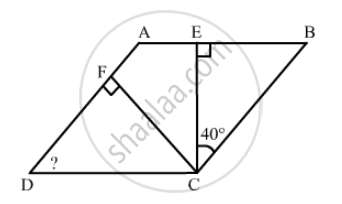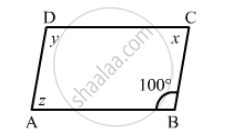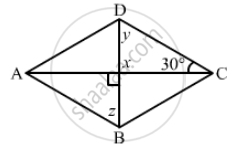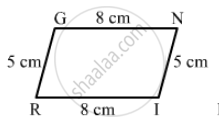Advertisements
Advertisements
प्रश्न
Find the angles marked with a question mark shown in Fig. 17.27

उत्तर
\[\text{ In } \bigtriangleup CEB: \]
\[\angle ECB + \angle CBE + \angle BEC = 180° (\text{ angle sum property of a triangle })\]
\[40° + 90° + \angle EBC = 180° \]
\[ \therefore \angle EBC = 50° \]
\[\text{ Also }, \angle EBC = \angle ADC = 50° \left( \text{ opposite angle of a parallelogram } \right)\]
\[\text{ In } \bigtriangleup FDC: \]
\[\angle FDC + \angle DCF + \angle CFD = 180° \]
\[50° + 90° + \angle DCF = 180° \]
\[ \therefore \angle DCF = 40° \]
\[\text{ Now }, \angle BCE + \angle ECF + \angle FCD + \angle FDC = 180° (\text{ in a parallelogram, the sum of alternate angles is } 180° )\]
\[50° + 40° + \angle ECF + 40° = 180° \]
\[\angle ECF = 180° - 50° + 40° - 40° = 50° \]
APPEARS IN
संबंधित प्रश्न
Name the quadrilaterals whose diagonals are perpendicular bisectors of each other
The following figure is parallelogram. Find the degree values of the unknowns x, y, z.

The following figure is parallelogram. Find the degree values of the unknown x, y, z.

Can the following figure be parallelogram. Justify your answer.

In a parallelogram ABCD, AB = 10 cm, AD = 6 cm. The bisector of ∠A meets DC in E, AEand BC produced meet at F. Find te length CF.
Which of the following statement is true for a rhombus?
It has only two pairs of equal sides.
Which of the following statement is true for a rhombus?
Its diagonals bisect each other at right angles.
Fill in the blank, in the following, so as to make the statement true:
A rhombus is a parallelogram in which ......
If the adjacent sides of a parallelogram are equal then parallelogram is a ______.
If a diagonal of a quadrilateral bisects both the angles, then it is a ______.
